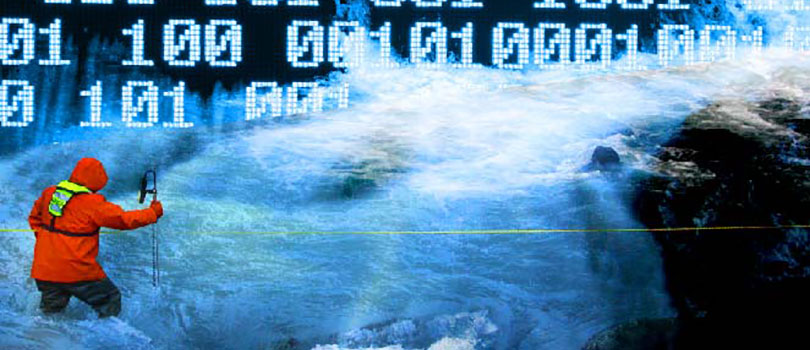
Stage-Discharge Rating Curves – Geophysics or Religion?
Almost everything we know about our global freshwater resources is due to the humble stage-discharge rating curve.
The vast majority of all flow data ever produced is the derived result of a transform from a variable that is easy to monitor continuously (stage) to a variable that is impossible to directly measure continuously (discharge).
This means we are dependent on rating curves for advancements in hydrological science; for flood forecasting; for drought management; for engineering designs that provide us with physical safety, transportation, water supply and waste disposal; for water management policies and decisions that ensure energy and food security. There are social, recreational and environmental health benefits to knowing water flow.
Given that this knowledge is so fundamental to our safety, health and prosperity one would expect global consensus on the science and practice of rating curve development and management.
The basic principles of fluid flow and the physical properties of water have been known for centuries. One could argue that the rating curve represents a fairly straightforward geophysical process relating the properties of water to the conveyance capacity of the channel at a unique location. For practical use, solving the Saint-Venant equation is an onerous proposition. However, the solution can be greatly simplified by acceptance of a few simplifying assumptions.
Introducing assumptions to the problem take us out of the realm of geophysics and into the realm of belief systems.
There are two primary dogma that yield many distinct belief systems:
The Reductionist Dogma:
It is believed that, for each channel control feature (there can be more than one), the standard equation Q=B(H-e)a is a very useful approximation. In this equation discharge (Q) is a power (a) function of stage (H) corrected with an offset value (e) multiplied by a coefficient (B). It is widely accepted that the coefficient represents information about channel width, slope and roughness, the offset represents an effective cease-to-flow elevation and the exponent represents information about channel shape.
- A high level of trust is put in human observations of the control conditions to: i) verify that fundamental assumptions are valid and ii) to provide interpretation of the correct form of the rating as guided by gaugings.
- A high level of trust is put in the assumptions implicit for statistical regression to calibrate a simple rating curve shape in a way that minimizes a performance metric for the fit of the curve to selected gauging’s (e.g. root mean square error).
The Holistic Dogma:
It is believed that the relationship between stage and discharge is inherently too complex to reliably be reduced to simple mathematics. The relationship is best represented as a table of rating points, a set of equations or a polynomial function.
- A high level of trust is put in experienced hydrographers hand-drawn rating curves. The curves may be generated on paper or by using a computerized graphical editor that reproduces the experience of visually identifying the form of the rating.
- A high level of trust is put in the assumptions implicit for statistical regression to calibrate a complex rating curve shape in a way that minimizes a performance metric for the fit of the curve to selected gauging’s (e.g. root mean square error).
- A high level of trust is put in actual gaugings. An investment in high frequency of gaugings is preferred over an investment in rating interpretation.
- A high level of trust is put in the analysis of the cross sectional survey data. An investment in analysis is preferred over an investment in gauging frequency.
Science arguments can be systematically resolved. Belief system arguments cannot.
As with the major religions these belief systems tend to be centered in geographic strongholds. Evangelical hydrographers who go on a mission to preach the gospel of their system to non-believers get boiled alive by the natives. There is little opportunity for discourse between practitioners of different belief systems.
Notwithstanding many historical, geographic, cultural and political influences on the development and persistence of different belief systems, there could be great value if everyone produced their data the ‘best’ possible way. The most likely outcome of religious adherence to deeply entrenched tradition is that nobody is producing their data the best possible way. The ‘best’ approach has yet to be discovered and that will require consideration and synthesis of the best of the best ideas arising from every tradition. That cannot happen until practitioners from different belief systems are actively working together and sharing ideas.
The ratings workshop in Christchurch NZ last spring is one small step toward enlightenment. We can do better. There is much still to be learned.
I would like to specifically call for feedback on this post. What is your experience with rating curve development? Does the metaphor of religion resonate with you? If so, what do you believe? If not, where is the evidence that science prevails over belief? Could there be a geophysical explanation for the global distribution of belief systems (e.g. a belief system may be optimally adapted to local geography, hydrology and hydraulic conditions)?


